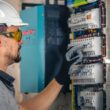Welcome to our comprehensive guide on the Cu + H2SO4 reaction! In this article, we will delve into the details of this chemical reaction, exploring its mechanism, applications, and significance. This reaction, involving the interaction of copper (Cu) with sulfuric acid (H2SO4), is of great interest in the field of chemistry due to its wide range of applications and implications.
The Cu + H2SO4 Reaction Explained
The Cu + H2SO4 reaction involves the reaction between copper and sulfuric acid. Sulfuric acid, with the chemical formula H2SO4, is a strong and highly corrosive acid, while copper is a transition metal with the symbol Cu. When copper comes into contact with sulfuric acid, a chemical reaction occurs, resulting in the formation of copper sulfate (CuSO4), water (H2O), and sulfur dioxide (SO2) gas.
This reaction can be represented by the chemical equation:
Cu + H2SO4 → CuSO4 + H2O + SO2
Mechanism of the reaction
The Cu + H2SO4 reaction involves several steps:
- Initial contact: Copper and sulfuric acid come into contact with each other.
- Ionization: Sulfuric acid ionizes in water, releasing H+ ions.
- Oxidation and Reduction: Copper loses electrons to form Cu2+ ions, while H+ ions are reduced to form H2O.
- Formation of Copper Sulfate: Cu2+ ions react with SO4^2- ions from sulfuric acid to form copper sulfate, a blue crystalline compound.
- Release of SO2: Excess heat can lead to the release of sulfur dioxide gas.
Applications and significance
The Cu + H2SO4 reaction finds various applications in industries and laboratories:
- Electroplating: The reaction is utilized in electroplating processes, where copper is plated onto surfaces to enhance conductivity and prevent corrosion.
- Chemical Manufacturing: Copper sulfate, a product of this reaction, is used in the manufacturing of various chemicals and products.
- Laboratory Studies: The reaction is often studied in laboratories to understand redox reactions, ion exchange, and stoichiometry.
Frequently Asked Questions (FAQs)
Q: What is the product of the Cu + H2SO4 reaction?
A: The products of this reaction are copper sulfate (CuSO4), water (H2O), and sulfur dioxide (SO2) gas.
Q: Is the Cu + H2SO4 reaction exothermic or endothermic?
A: The reaction is exothermic, meaning it releases heat energy during the process.
Q: Why is copper sulfate important?
A: Copper sulfate has various applications, including its use as a fungicide, herbicide, and in educational demonstrations.
Q: Can I perform this reaction at home?
A: This reaction involves the use of concentrated sulfuric acid, which is highly corrosive and dangerous. It should only be conducted by professionals in controlled environments.
Q: What safety precautions should be taken when working with sulfuric acid?
A: When working with sulfuric acid, it’s crucial to wear appropriate protective gear, work in a well-ventilated area, and follow proper handling and disposal procedures.
Conclusion
The Cu + H2SO4 reaction is a fascinating chemical process with applications in various industries and educational settings. Its role in electroplating, chemical manufacturing, and laboratory studies highlights its importance in understanding fundamental chemical principles. However, it’s essential to handle the reaction with caution due to the corrosive nature of sulfuric acid. We hope this guide has provided you with a comprehensive understanding of the Cu + H2SO4 reaction.




